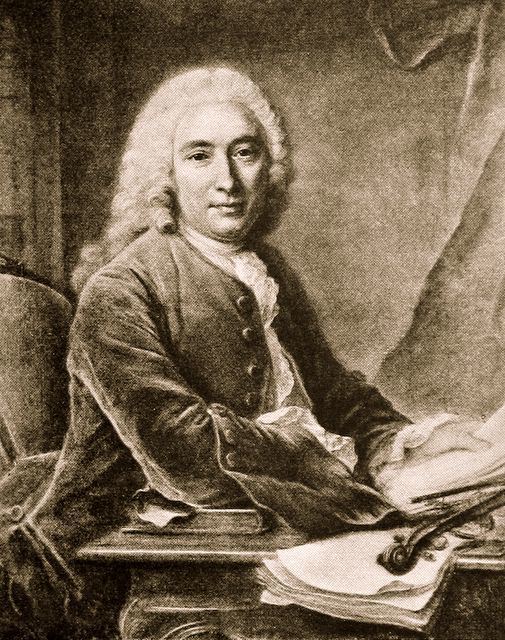First performance 1721 Language French | Librettist Pierre-Charles Roy | |
 | ||
Composers André Cardinal Destouches, Michel Richard Delalande Similar Callirhoé, Zaïs, Les fêtes d'Hébé, L'Europe galante, Miriways | ||
Les élémens (The Elements), or Ballet des élémens, is an opéra-ballet by the French composers André Cardinal Destouches and Michel Richard Delalande (or de Lalande). It has a prologue and four entrées. The libretto was written by Pierre-Charles Roy.
Contents
Composition
Destouches was responsible for most of the music. It has never been ascertained how much each composer contributed to the composition. In a 1726 letter, Destouches wrote to Antonio I, Prince of Monaco: "We were ordered to work in partnership; he [Delalande] wrote very fine things whose details I implore you to spare me, for he demanded of me that we should be covered by the same cloak". Delalande probably wrote the overture, much of the prologue and some parts of the first entrée. Jean Balon provided the choreography.
Les élémens has the typical structure of the opéra-ballet: its four entrées are musically and dramatically independent, but topically related to one another. Its subject matter, however – gods, heroes and ancient Romans – relates it more to the special type of opéra-ballet called "ballet-héroïque".
Performance history
The opera was first performed at the Tuileries, Paris on 31 December 1721, with the 11-year-old Louis XV participating in the dancing. It was revived by the Paris Opera at the Palais-Royal theatre from 29 May 1725, with increasing success, the degree of which "may be gauged by the fact that it remained in the repertory for more than 50 years and was revived in 1727, 1734, 1742, 1767, 1771, 1776, 1778, and 1780", and that it inspired "three parodies: Momus exilé (1725) at the Théâtre des Italiens; Le chaos (1725) at the same theatre; Il était temps (1754) at the Saint-Laurent fair". It was also revived at Madame de Pompadour's Théâtre des Petits Appartements, on the Grand Escalier des Ambassadeurs in the Palace of Versailles, on 23 December 1748, in which Madame de Pompadour herself performed.
Les élémens was Destouches's most successful work, and his master Delalande's only stage work to appear at the Paris Opéra. At court it "marked the end of several eras: it was Lalande's final stage work, Louis XV's last stage appearance and the final French court ballet".
There was a modern revival at the Opéra Royal de Versailles on 7 October 2001 under Jérôme Corréas, with Isabelle Poulenard, Françoise Masset, Jean-François Lombard, Matthieu Lecroart, and Renaud Delaigue.
Synopsis
The following synopsis is based on Pitou (1985).
Prologue: Chaos
After Destiny makes the elements replace chaos, Venus complains about her exclusion from the undertaking, Destiny mollifies her by showing her a statue of her future son, Louis XV, who is celebrated by a chorus and is committed to the elements' favour.
1st entrée: Air
Aroused by Mercure to be less aloof, Ixion refuses Junon's order to spy upon unfaithful Jupiter's movements and instead declares his love for her. This provokes a terrible fit of anger on her part. As a punishment, Jupiter will consign him to the depths of Hades.
2nd entrée: Water
After refusing to marry Eole on account of his bad temper, and because she already loves a stranger from afar, Leucosie welcomes Arion, the stranger she loves, who has arrived on the back of a dolphin, to Neptune's palace. Arion too falls in love with Leucosie. Neptune recognizes him as his own son and orders his marriage to Leucosie.
3rd entrée: Fire
This entrée is set in the vestibule of the temple of Vesta, where the priestess Emilie attends to the goddess's fire for the last time, having received permission to marry Valère. When Valère comes to the temple, Emilie tells him that she had a nightmare in which Vesta had appeared with a great crash, mad with rage, and had struck him dead by lightning. While Valère is trying to reassure her, the temple plunges into darkness, as the sacred fire has gone out: Emilie takes the blame for neglecting it and refuses to flee with her lover, bravely willing to face her deadly punishment. However, Cupid appears over a cloud, relights the sacred fire and blesses the wedding of his two followers.
4th entrée: Earth
Pomone seems to disregard love, so Vertumne, who is in love with her, disguises himself as a woman, Nérine, in order to be allowed to approach her. In this disguise, Vertumne witnesses Pomone rejecting Pan's approaches, and then is made aware by her of her secret love for him. He reveals himself and the entrée ends in a ballet and chorus celebrating Love.
Recordings
Excerpts from the work have been recorded by the Academy of Ancient Music, conducted by Christopher Hogwood, Decca (L'Oiseau-Lyre) 475 9100 (CD).
